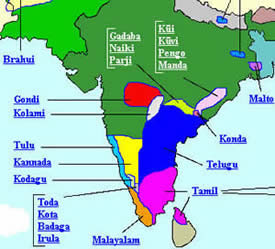 Introduction
Introduction Dravidian Language Family Dravidian Language FamilyNothing is known definitely about the origin of the Dravidian language family. Dravidian languages were first recognized as an independent family in 1816 by Francis W. Ellis, a British civil servant. The term Dravidian was first employed by Robert A. Caldwell, who introduced the Sanskrit word dravida (which historically meant Tamil) into his Comparative Grammar of the Dravidian or South Indian Family of Languages (1856). At present, speakers of the Dravidian languages are concentrated in the southern portion of India, while speakers of the Indo-Aryan language predominate in the northern portion of the country. A well-established hypothesis is that Dravidian speakers were originally spread across all of India. The Indo-Aryan languages were not native to India, rather they were introduced by Aryan invaders from the north. A form of Dravidian must have been spoken in northern India before the arrival of the Aryans. The replacement of the Dravidian by the Aryan languages was probably completed before the beginning of the Christian Era. The Dravidian language familytoday includes 75 languages spoken by over 200 million people in southern India, Sri Lanka, certain areas of Pakistan and in Nepal. Tthe prevailing theory is that speakers of Dravidian languages split into Northern, Central, and Southern ancestral languages somewhere around 1,500 BC. Dravidian languages are usually broken up into the following groups, largely based on their geographical distribution. As you can see, some of them have very large populations of speakers and are fairly well known, while others are relatively small and generally unknown. The table below lists only languages with 60,000 or more speakers. Some of the figures may be out of date.
¡@
| ||||||||||||||||||||||||||||||||||||||||||||||||||||||||||||||||||||||||||||
| Status Tamil, Malayalam, Telugu, and Kannada are official languages of India. They have been used in administration and literature since their first attested beginning. All four possess a great wealth of a variety of written texts. All four languages are characterized by a dichotomy between the standardized, formal language and colloquial speech. All four experienced little difficulty in accommodating social, political, and economic changes that swept India in the 20th century. All four languages are used in teaching basic courses in the sciences and in humanities. All four have succeeded in developing new technical terms, using English, Sanskrit, or indigenous models. Click here to learn more about the Dravidian languages of India. | |||||||||||||||||||||||||||||||||||||||||||||||||||||||||||||||||||||||||||
